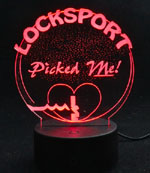Categories
Categories
Brands
Brands
- Home
- How To Pick A Lock
How To Pick A Lock
How to Pick a Lock easily with Lock Picks
It's not that hard. It's basically a matter of developing some muscle memory and feel. Hand-eye coordination has little to do with it since you really never see what's going on inside the lock (unless, of course, you've been smart and have purchased one of our CutAway Practice Locks!)
Yes, it's true you can pick a lock with your eyes closed, though having to feel around for tools and to find the lock's keyway will slow you down a tad. Seriously, though, learning to use lock picks is mostly a matter of getting to know and understand the reason lock picking works in the first place and then --- practice, practice, practice.
GREAT SOURCES FOR SELF-TRAINING
Books ::::
LOCK PICKING BASICS $19.95 SECRETS OF LOCK PICKING $24.95
Here is a link to our bookstore
- - - - - - - - - - - - - - - - - - - - - - - - - - - - - - - - - - - - - -
You get a wealth of lock picking information in three different media: CD-ROM, DVD, and paperback manual. All three are different and separate resources:
Locksmith's Master Resource CD (w/4 pdf ebooks)
Lock Picking for the New Millenium (DVD)
The Visual Guide to Lockpicking (book)
I could leave it at that without seriously understating the subject, but I instead I will endeavor to give you some very helpful tips and explanations which should make learning to pick locks much easier. I will assume for the time being that the reader is a beginner, with little or no lockpicking experience. To learn how to pick locks you must first have a real desire to do so. That may sound pretty obvious but don't think for a minute that you will pick this up without some true dedication . . . unless you turn out to be one of those few who happen to possess a natural talent for it (maybe 1 out of 100 people do).
HPC Deluxe Pick Set - My personal favorite
If you are a beginning Locksmith, or a student of the trade just starting out in your quest to attain lockpicking skills, you must obviously invest in a few inexpensive items. To pick locks you must have lock picks. Making your own is never a good idea because you will become accustomed to the feel of homemade tools and this will NOT translate well when you finally decide to buy the real deal. It may be a neat challenge -- a MacGiver sort of experience -- but if you are serious and want to teach yourself how to pick a lock you should start out with REAL lockpicks. They are not costly if you select carefully. We have a huge variety of low cost lock pick sets, many of them ideal for beginners.
Next, find something to practice on. For starters you will likely go around your house trying to pick all the keyed locks you can find. It's a good start, but consider that most homes have all the locks keyed alike or, at worst, maybe two different keys. You will quickly get used to picking a single combination and you will soon want to move on. Going around the neighborhood with lock picks is not the smartest idea. In many jurisdictions it is illegal to possess these tools (this is something you are responsible to look into -- we cannot police customers and we must leave it to you to determine if possession of lockpicks is permissible where you live). Even if they are perfectly legal, you will not find acceptance skulking around trying to pick open doors that you don't have permission to open. Nice way to end up in jail.
No, what you need is at least a few Practice Locks. Check out our selection, it's the best on the Internet because we are without a doubt the leader in lockpicking practice items. You might consider buying one of our Starter Kits, which will include both a pick set and from 1 to 7 practice locks, depending on the kit you choose.
Next comes the Practice Lock Stand, to hold your practice locks firmly while you go about practicing lock picking. How do you pick a lock easily? It depends on several things. First, it depends on how difficult is the lock's combination -- or tumbler grouping. Some locks are quite easily picked because they were combinated with a nearly 'flat' combination. Best bet is to buy one of our Complete Starter Kits because you'll get a variety of practice locks with a variety of combinations. You'll even get a 2-pinned or 3-pinned lock with which to begin practicing (standard number of pins, or tumblers, in a residential lock is 5 -- 6 for commercial locks). If you begin with a 2-pinned lock, you will almost surely have it picked in a matter of minutes if not seconds. It is primarily to acquaint you with how it FEELS when the lock pick moves the tumblers properly and the lock turns. In other words, you learn through feedback. Your brain will log and memorize all the subtle feelings that come through your fingers, wrist and arm as the lock picks. Practice with the 2- or 3-pinned practice lock until you can consistently and easily pick it.
Learning how to pick a lock easily involves learning how to use lock picks. Like learning to use any tool, this involves trial and error. I know many Locksmiths and no two of them have the same technique when it comes to how they pick a lock. Some are more comfortable with course, large movements (raking motions as opposed to pin-by-pin picking). Others like myself are more successful with small and calculated motions of the lock pick, using variety and frequent changes in tension pressure to urge the pins upward until they meet the shear line. You will have to practice and practice and practice some more before you realize your own best methods. The more you succeed in picking locks, the more consistent will be that success.
Here are some simple tips for lock picking, basic in nature but important nonetheless:
- Lubricate your lock first, using an oil-less lubricant. Do not use graphite, it makes a bloody mess.
- Work the tumblers by running a rake pick in and out of the keyway a few times.
- Start with your pick all the way to the rear of the plug, apply a TINY amount of turning tension, and slowly slide the pick toward you.
- As you move it toward you, put a small amount of upward pressure on the tip of the pick, keeping your tension tool engaged.
- Repeat this motion several times. In many cases, this very simple procedure will pick some of the pins.
- Change the turning pressure but do NOT release it entirely. If you do, any picked tumblers will un-pick and fall back into the lock plug.
- Vary the amount of upward pressure on the pick's tip. If you feel the plug trying to rotate (this will be extremely subtle), you are picking the lock.
These tips are for your first attempts, designed to give you some idea of what it feels like to pick a lock. This is sometimes done easily, but more often it will require some work. If it were TOO easy, there would be no prestige in saying you have learned how to pick lock. Also, no one's home would be safe from lockpickers.
An important part of learning how to pick locks is to take advantage of instructional materials. We offer one of the most popular lockpick books around, called simply "How to Pick Locks". You can find this PDF e-book in our web site. Just do a search for the title. There are other materials you can buy that easily teach you how to pick locks such as the great DVD on our site, "Lock Picking for the New Millenium". What a cool way to get your instruction . . . by watching it being done.
Practice.


 Loading... Please wait...
Loading... Please wait... 


